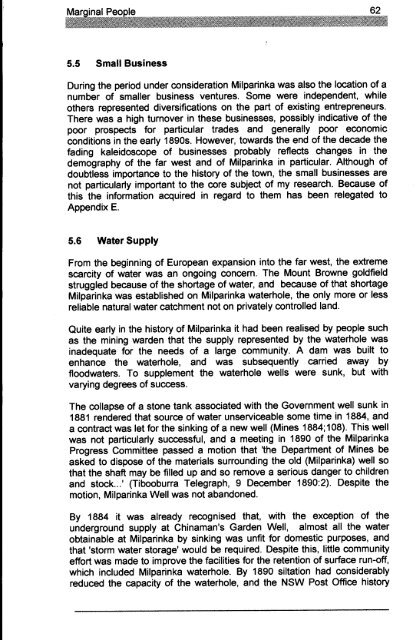Adec Preview Generated PDF File - The Sydney eScholarship ...
Adec Preview Generated PDF File - The Sydney eScholarship ...
Adec Preview Generated PDF File - The Sydney eScholarship ...
Create successful ePaper yourself
Turn your PDF publications into a flip-book with our unique Google optimized e-Paper software.
5.5 Small Business<br />
During the period under consideration Milparinka was also the location of a<br />
number of smaller business ventures. Some were independent, while<br />
others represented diversifications on the part of existing entrepreneurs.<br />
<strong>The</strong>re was a high turnover in these businesses, possibly indicative of the<br />
poor prospects for particular trades and generally poor economic<br />
conditions in the early 1890s. However, towards the end of the decade the<br />
fading kaleidoscope of businesses probably reflects changes in the<br />
demography of the far west and of Milparinka in particular. Although of<br />
doubtless importance to the history of the town, the small businesses are<br />
not particularly important to the core subject of my research. Because of<br />
this the information acquired in regard to them has been relegated to<br />
Appendix E.<br />
5.6 Water Supply<br />
From the beginning of European expansion into the far west, the extreme<br />
scarcity of water was an ongoing concern. <strong>The</strong> Mount Browne goldfield<br />
struggled because of the shortage of water, and because of that shortage<br />
Milparinka was established on Milparinka waterhole, the only more or less<br />
reliable natural water catchment not on privately controlled land.<br />
Quite early in the history of Milparinka it had been realised by people such<br />
as the mining warden that the supply represented by the waterhole was<br />
inadequate for the needs of a large community. A dam was built to<br />
enhance the waterhole, and was subsequently carried away by<br />
f1oodwaters. To supplement the waterhole wells were sunk, but with<br />
varying degrees of success.<br />
<strong>The</strong> collapse of a stone tank associated with the Government well sunk in<br />
1881 rendered that source of water unserviceable some time in 1884, and<br />
a contract was let for the sinking of a new well (Mines 1884;108). This well<br />
was not particularly successful, and a meeting in 1890 of the Milparinka<br />
Progress Committee passed a motion that 'the Department of Mines be<br />
asked to dispose of the materials surrounding the old (Milparinka) well so<br />
that the shaft may be filled up and so remove a serious danger to children<br />
and stock.. .' (Tibooburra Telegraph, 9 December 1890:2). Despite the<br />
motion, Milparinka Well was not abandoned.<br />
By 1884 it was already recognised that, with the exception of the<br />
underground supply at Chinaman's Garden Well, almost all the water<br />
obtainable at Milparinka by sinking was unfit for domestic purposes, and<br />
that 'storm water storage' would be required. Despite this, little community<br />
effort was made to improve the facilities for the retention of surface run-off,<br />
which included Milparinka waterhole. By 1890 siltation had considerably<br />
reduced the capacity of the waterhole, and the NSW Post Office history




